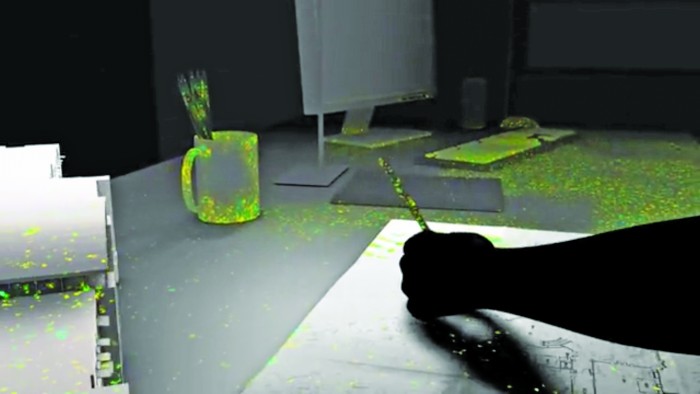 Natural Sciences
Natural Sciences
Better Living Through Microbes

One in twenty patients gets an infection while hospitalized. But what if we could design hospitals for zero infection risk, using the microbial world that surrounds us?
Associate professor of biology Jessica Green touched on this idea during a recent TED Talk; in fact, as a TED fellow, she has been promoting the concept of better living through microbes at numerous TED Talks over the last few years.
Green is fascinated by the invisible, microbial world of bacteria, viruses and fungi that cover everything around us—and the world of microbes covering our bodies, too. These worlds interact constantly; the interactions could be used to improve our health in unprecedented ways, she says.
To better understand the microbiology of indoor environments, Green and a team of biologists and architects recently “swept” the UO’s Lillis Business Complex, using special vacuum cleaners to collect samples of microbes found throughout the building—classrooms, hallways, bathrooms, offices and elsewhere.
Reporting in the Public Library of Science, the team found that the design of the building clearly influenced what microbes were found where. Alphaproteobacteria, for example, were abundant in offices, while Lactobacillus—associated with the human gut—were most prevalent in bathrooms.
The building’s air-handling units and ventilation system played a fundamental role in determining which microbes were present and where they were found, the team reported. For example, offices, especially those with windows, tended to have higher levels of soil-dwelling Methylobacterium. Mechanically ventilated offices, on the other hand, had more Deinococcus, which may be better suited to the hot dry air pumped out by the heating system in these rooms.
In a related study, the team explored the impact of an energy-saving ventilation strategy for classrooms throughout Lillis.
They found that the building’s unique capacity to “night flush” air resulted in airborne microbiota inside classrooms that closely mirrored outdoor air. In contrast, when the night flush system was turned off, the airborne microbiota remained relatively stagnant inside.
The work was done by the university’s Biology and the Built Environment Center, which is headed by Green, biology professor Brendan Bohannan and architecture professor G. Z. “Charlie” Brown. The goal of the BioBE Center is to improve the design and operation of buildings to promote human health and environmental sustainability.
The prevailing wisdom for the design of many buildings is to “keep the outside out,” Green said—but we don’t know if this is always healthiest for the occupants.
Green calls her concept “bioinformed design”: the idea that everything we design and create—from buildings to vehicles to handheld devices—could be done with an interest in promoting interactions with the microbial world that improve health.
Airplanes, long considered vectors for the spread of disease, could use bioinformed design, for example. Green’s idea could be adapted to almost anything—even telephones could possibly be designed with beneficial microbes that would enter our bodies and improve our health every time we speak into a handset.
One of Green’s favorite beneficial microbes is called BLIS (bacteriocin-like inhibitory substances). It’s a probiotic for the mouth and throat.
“It’s been shown to both ward off pathogens and bad breath,” Green said. “Wouldn’t it be great if we all had BLIS on our phones?”
— Matt Cooper


 Twitter
Twitter Facebook
Facebook Forward
Forward